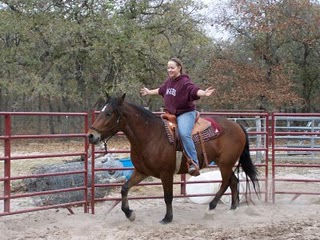Steering Your Horse With No Reins
 1. Start out at home, off your horse and on a chair. Sit on your hands,
palms up and settle into your seat as though you are riding your horse. Practice shifting your weight from
the left to the right without leaning from side to side. You will feel pressure on one hand and a release
of pressure on the other, doing this seated in front of a mirror will help you know when you are
leaning. 1. Start out at home, off your horse and on a chair. Sit on your hands,
palms up and settle into your seat as though you are riding your horse. Practice shifting your weight from
the left to the right without leaning from side to side. You will feel pressure on one hand and a release
of pressure on the other, doing this seated in front of a mirror will help you know when you are
leaning.
2. Put a bridle on your horse, mount and hold your reins as you normally
would. Keep them loose, however. They are only there to help you in the case of an emergency.
3. To practice steering, set the reins down and work on using your seat and
legs. Horses will shift away from pressure, so when you want them to move right you will apply pressure to the
left and vice versa. Press your calf into the left side to turn right and your right calf in to turn right. Be
careful! Too much pressure may encourage your horse to speed up.
4. Stopping a horse requires more off-horse practice, so return to your chair
and practice shifting your pelvis forward. This may feel to you like a release of pressure, but horses have
different spines and to them this is a reason to stop.
5. Return to your horse and practice. Some horses may need leg pressure and
others may need extra practice. This is why you need your reins; if they do not stop you can use the reins in
tandem with your motion to show them that you want them to stop when you make that movement. Don't say woah
unless they refuse to stop.
Tips:
If you are using a western style saddle, keep the reins attached to the saddle horn so that they are not lost
if the horse tosses his head.
Keep you heels down, keep your leg on the horse, and hold onto the horn with
one hand just in case.
You will want to practice this continually for a few months before attempting
to go out without your reins. Always keep a bridle and reins on your horse for safety's sake; if your horse
spooks or startles you will have no way to stop them otherwise. Remember that not all horses will take to this
quickly. As with any training of a new task, you must have patience and understanding. If you do not have the
time to fully dedicate to teaching this to your horse, then don't start. Always remember to ride with a partner
and to keep good distance between yourself and other horses.
Related Articles
Common Horse Riding Terms
Most Famous Racing Horses
5 Fastest Horses in Kentucky Derby
History
What to Expect at Your First Riding
Lesson
Top Five Racing Breeds
Tips for Horseback Riding
What to Look for in a Horse Riding
Instructor
Steering Your Horse With No Reins
Tips for Picking a Winning Race Horse
Horseback Riding Equipment - What You
Need to Have
What to Wear When You Go Riding
The 5 Most Famous Horse Races
Questions to Ask Potential Riding
Instructors
Ride and Tie- A Fun Horse Riding Pastime
Quick Tips for Breaking a Horse
Learning to Bail or Hang On
|